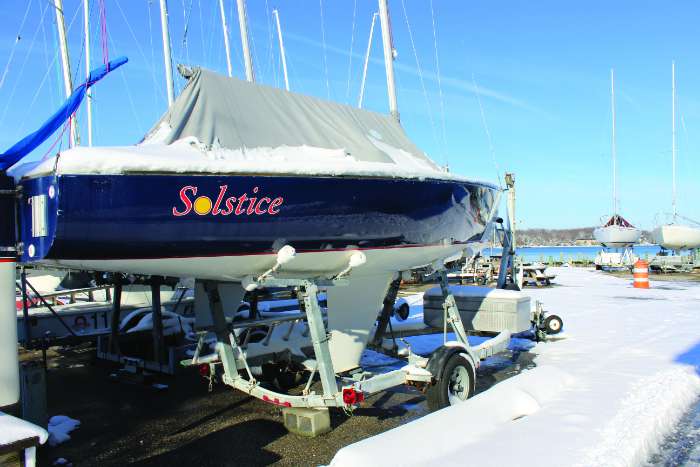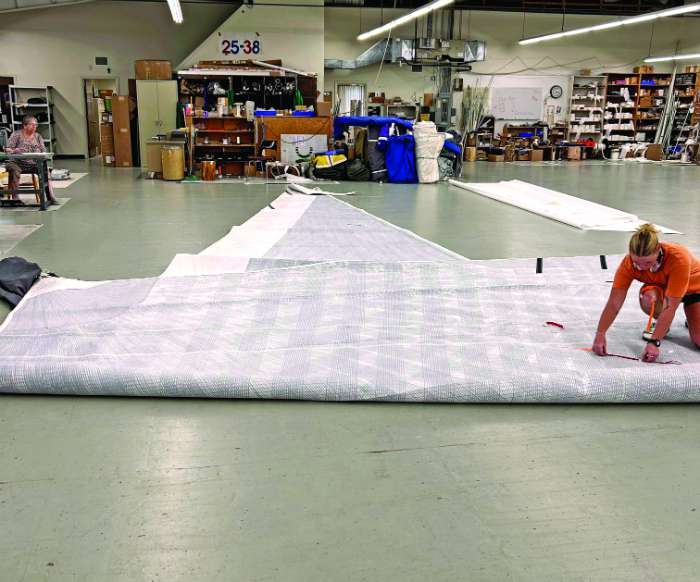Decommissioning Your Sailboat for Winter
Nobody likes to see the summer sailing season end, of course, and preparing for winter, for the sailboat owner, can be a bit more complicated than it is for the powerboat owner because, essentially, one has two propulsion systems to consider: the sailing rig and the auxiliary engine. In warmer climates, there is usually no real winterization, only periodic maintenance, since the boat will probably be used year-round, but up in the mid-Atlantic states and New England, colder temperatures and freezing are added complications. To simplify matters, I treat the rig and the ‘iron jenny’ as separate worlds.

If you are keeping your boat at a marina or in a boatyard, and you know that the yard’s mechanic is competent and has a good reputation, it is wise, though not necessarily cheaper in the short term, to use the yard’s mechanic. Often, the yard will offer a checklist of services for the mechanic to perform, ranging from oil and antifreeze changes to flushing the raw-water system with non-toxic antifreeze to prepare the boat for out-of-water storage for the winter. Always remove the cap plate from the raw-water pump and remove the impeller. Check its condition. Always put a new one in come spring; if the impeller is in very good shape, put it aside as a spare, but don’t re-use it even if it looks fine.
Why winterizing is essential
If you live in a region where winter brings freezing temperatures, inadequate preparation can lead to cracked engine blocks, burst plumbing, mold growth, and a host of other costly repairs. Even if your boat will be stored in the water, freezing air and snow can inflict significant damage. Dedicating time to a thorough winterization process is an investment in your sailboat’s longevity.
Preparations before you begin
Always keep a journal for your boat, a ‘nothing’ book of lined or blank pages outlining your sailboat winterization (and in the spring, commissioning) process steps as well as listing all the items that you’ll need, including optional items.
Gather supplies: You’ll need antifreeze (marine, non-toxic), engine fogging oil, fuel stabilizer, cleaning products, lubricants, desiccants, plastic wrap or tarps, and plenty of rags.
Select a storage location: Decide whether your boat will be stored in the water, on a trailer, or on blocks. Each location may require slightly different preparations.
Check the owner’s manual: Always consult the manufacturer’s recommendations for your particular model and engine.

Remove valuables and electronics
Remember to remove personal items, portable electronics, and valuables from the boat. Take home everything portable. This prevents theft and damage from condensation. Store electronics in a dry, climate-controlled environment, and remove cushions, when possible, to store at home or in a dry, well-ventilated locker.
Clean inside and out
Give your boat a meticulous cleaning.
Wash the hull and deck with mild soap; rinse thoroughly to remove salt and grime.
Scrub away or power wash any algae or barnacles on the bottom.
Clean the bilge, galley, and head. Remove all perishable food, drinks, and trash to prevent unpleasant odors and pests.
Vacuum upholstery, launder fabrics, and wipe down all surfaces with a mildew-resistant cleaner.
Many sailors remove their sails and store them in the care of a sailmaker or sail loft; I found that to be a cost-effective way to keep them safe, dry, and out of the way. Sometimes small repairs might be needed, or the sails may need to be washed or spot-cleaned. No matter what is needed, I know that in the spring, my sails will be all ready to go back on (or ‘bent’ on) for the new season.
Drain water systems
Water left in tanks, pipes, or engines can freeze and expand, causing cracks and ruptures.
Drain all freshwater tanks, hot water heaters, and lines. Open every tap and allow water to run out.
Pump out the holding tank and flush the head with freshwater.
Pour non-toxic, marine-grade antifreeze into all drains, toilets, and bilge pumps.
If your boat has a pressurized system, pump antifreeze through the lines until colored liquid runs out of all faucets.

Fuel system maintenance
Fill the fuel tank to 95 percent capacity to minimize condensation; leaving space for expansion helps prevent leaks.
Add a fuel stabilizer and run the engine for at least 15 minutes to ensure stabilized fuel reaches all components.
Change all fuel filters and water separators. Check for leaks or corrosion around the tank.
Engine and propulsion system
If you don’t contract the yard to winterize your engine, there are a few procedures that you can perform yourself, such as flushing the engine with fresh water to remove salt and debris. Use “ear muffs” for outboards, or follow the manual for inboards.
Change the oil and replace the oil filter to prevent contaminants from sitting and sediments from collecting over the winter.
Add non-toxic antifreeze through the raw-water intake and run the engine briefly until it exits the exhaust.
For gasoline engines, spray some fogging oil into the carburetor while running to coat internal parts.
Inspect the propeller; check for fishing line or corrosion. Check the stuffing box and grease ports, and lubricate all moving parts: steering cables, throttle controls, hinges, and latches.
Remove and replace zinc anodes where necessary.
Batteries and electrical system
Fully charge all batteries, disconnect and remove them from the boat if possible. Store batteries in a cool, dry place off the ground.
Clean terminals and coat with petroleum jelly or dielectric grease.
If you must leave batteries aboard, ensure that a trickle charger or solar maintainer is installed.
Turn off all switches, breakers, and electrical devices. Remove fuses for added protection.
Sails, rigging, and canvas
We discussed removal, cleaning, and proper storage of the sails, and to that we must add the following:
Inspect all standing and running rigging for wear, corrosion, or fraying. Replace damaged lines. Remember that continuous exposure of halyards and running rigging to the elements (i.e., ultraviolet radiation) will cause them to slowly deteriorate, so check them carefully.
Loosen halyards and lines to reduce tension on the rig.

Interior and ventilation
Prop open locker doors and set out moisture absorbers or desiccants to prevent mold and mildew.
Leave interior cushions standing on edge to promote airflow.
Open bilge access points if possible.
Consider using a dehumidifier if the boat is stored indoors and power is available.
Exterior protection
Apply a protective wax to the hull to protect against dirt and UV damage.
Cover your sailboat with a well-fitted tarp or custom canvas cover (If you use shrink-wrap, make sure your marina has a recycling system in place come spring). Ensure that the cover is secure but ventilated to prevent moisture buildup.
If on land, remove the drain plug and remember to reinstall it in the spring.
For boats stored in the water, check dock lines and install chafe guards. Consider adding a bubble skirt or de-icers to keep water circulating around the hull.
Extra tips for peace of mind
Label all disconnected wires, hoses, and parts for easy reassembly in spring.
Leave a note inside the cabin listing critical steps taken—this helps you or a future owner keep track of maintenance routines.
If you have contracted with your marina for winterization services, request a written report of work completed.
Don’t forget to visit your boat!
Visit your boat periodically during the winter to check for problems, clear snow, and ensure covers remain secure.
Winterizing your sailboat is a labor of care. As with all boat maintenance, patience, diligence, and a little extra effort now will spare you from headaches when spring finally arrives.

Winterization of Sails
When winterizing your sailboat, the best practice is to remove your sails and take them to a reputable sail loft or sailmaker, preferably the loft that made them. Sails are just as critical as your auxiliary engine, if not more so, and although the care of your sails is quite different than caring for the ‘iron jenny,’ it should be no less meticulous.
Your sailmaker can wash and dry your sails and inspect them for tears and chafe and make needed repairs that will make later repairs unnecessary, or at least minimal. Your sails will be properly folded and stored for the winter.
People who simply bag and store their sails in a backyard shed or garage are taking a real risk. Mice will nest in your sails, chew them up, soil them with urine and feces, and have their babies in there, all of which can result in irreparable damage to sails worth thousands of dollars.
~By Capt. Michael L. Martel
Find more winterization tips here.




